Introduction to warbleR
Marcelo Araya-Salas, PhD & Grace Smith-Vidaurre
2024-02-28
Source:vignettes/Intro_to_warbleR.Rmd
Intro_to_warbleR.Rmd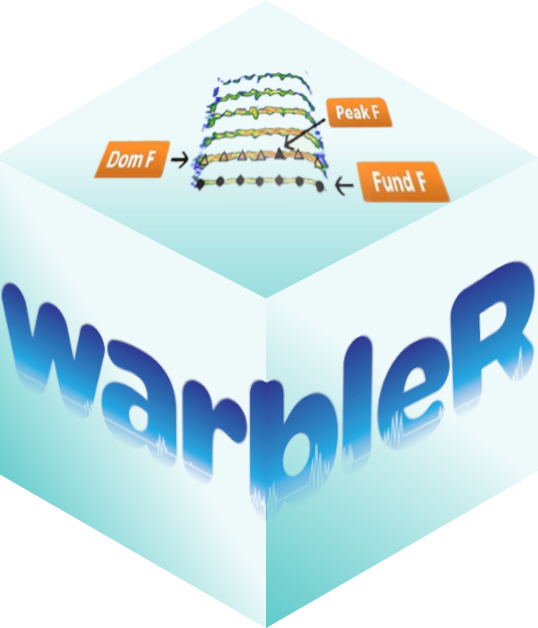
The warbleR package is intended to facilitate the analysis of the structure of the animal acoustic signals in R. Users can enter their own data into a workflow that facilitates spectrographic visualization and measurement of acoustic parameters warbleR makes use of the fundamental sound analysis tools of the seewave package, and offers new tools for acoustic structure analysis. These tools are available for batch analysis of acoustic signals.
The main features of the package are:
- The use of loops to apply tasks through acoustic signals referenced in a selection table
- The production of image files with spectrograms that let users organize data and verify acoustic analyzes
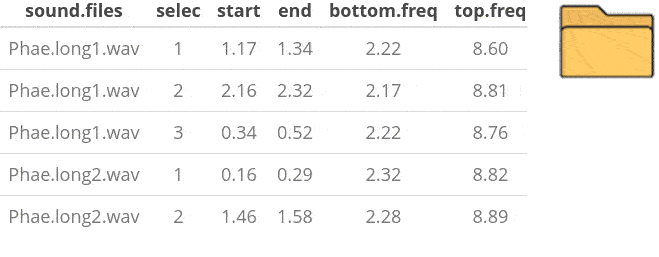
The package offers functions for:
- Browse and download recordings of Xeno-Canto
- Explore, organize and manipulate multiple sound files
- Detect signals automatically (in frequency and time)
- Create spectrograms of complete recordings or individual signals
- Run different measures of acoustic signal structure
- Evaluate the performance of measurement methods
- Catalog signals
- Characterize different structural levels in acoustic signals
- Statistical analysis of duet coordination
- Consolidate databases and annotation tables
Most of the functions allow the parallelization of tasks, which distributes the tasks among several cores to improve computational efficiency. Tools to evaluate the performance of the analysis at each step are also available. All these tools are provided in a standardized workflow for the analysis of the signal structure, making them accessible to a wide range of users, including those without much knowledge of R. warbleR is a young package (officially published in 2017) currently in a maturation stage.
Selection tables
These objects are created with the selection_table()
function. The function takes data frames containing selection data (name
of the sound file, selection, start, end …), verifies if the information
is consistent (see the function checksels() for details)
and saves the ‘diagnostic’ metadata as an attribute. The selection
tables are basically data frames in which the information contained has
been corroborated so it can be read by other warbleR
functions. The selection tables must contain (at least) the following
columns:
- sound files (sound.files)
- selection (select)
- start
- end
The sample data “lbh_selec_table” contains these columns:
data("lbh_selec_table")
lbh_selec_table| sound.files | channel | selec | start | end | bottom.freq | top.freq |
|---|---|---|---|---|---|---|
| Phae.long1.wav | 1 | 1 | 1.1693549 | 1.3423884 | 2.220105 | 8.604378 |
| Phae.long1.wav | 1 | 2 | 2.1584085 | 2.3214565 | 2.169437 | 8.807053 |
| Phae.long1.wav | 1 | 3 | 0.3433366 | 0.5182553 | 2.218294 | 8.756604 |
| Phae.long2.wav | 1 | 1 | 0.1595983 | 0.2921692 | 2.316862 | 8.822316 |
| Phae.long2.wav | 1 | 2 | 1.4570585 | 1.5832087 | 2.284006 | 8.888027 |
| Phae.long3.wav | 1 | 1 | 0.6265520 | 0.7577715 | 3.006834 | 8.822316 |
| Phae.long3.wav | 1 | 2 | 1.9742132 | 2.1043921 | 2.776843 | 8.888027 |
| Phae.long3.wav | 1 | 3 | 0.1233643 | 0.2545812 | 2.316862 | 9.315153 |
| Phae.long4.wav | 1 | 1 | 1.5168116 | 1.6622365 | 2.513997 | 9.216586 |
| Phae.long4.wav | 1 | 2 | 2.9326920 | 3.0768784 | 2.579708 | 10.235116 |
| Phae.long4.wav | 1 | 3 | 0.1453977 | 0.2904966 | 2.579708 | 9.742279 |
… and can be converted to the selection_table format like this (after saving the corresponding sound files):
data(list = c("Phae.long1", "Phae.long2", "Phae.long3", "Phae.long4"))
writeWave(Phae.long1, file.path(tempdir(), "Phae.long1.wav"))
writeWave(Phae.long2, file.path(tempdir(), "Phae.long2.wav"))
writeWave(Phae.long3, file.path(tempdir(), "Phae.long3.wav"))
writeWave(Phae.long4, file.path(tempdir(), "Phae.long4.wav"))
# parametros globales
warbleR_options(wav.path = tempdir())
st <- selection_table(X = lbh_selec_table, pb = FALSE)
st
[30mchecking selections (step 1 of 1):
[39m
[30mObject of class
[1m'selection_table'
[22m
[39m
[90m* The output of the following call:
[39m
[90m
[3mselection_table(X = lbh_selec_table, path = tempdir())
[23m
[39m
[90m
[1m
Contains:
[22m * A selection table data frame with 11 rows and 7 columns:
[39m
[90m|sound.files | channel| selec| start| end| bottom.freq|
[39m
[90m|:--------------|-------:|-----:|------:|------:|-----------:|
[39m
[90m|Phae.long1.wav | 1| 1| 1.1694| 1.3424| 2.2201|
[39m
[90m|Phae.long1.wav | 1| 2| 2.1584| 2.3215| 2.1694|
[39m
[90m|Phae.long1.wav | 1| 3| 0.3433| 0.5183| 2.2183|
[39m
[90m|Phae.long2.wav | 1| 1| 0.1596| 0.2922| 2.3169|
[39m
[90m|Phae.long2.wav | 1| 2| 1.4571| 1.5832| 2.2840|
[39m
[90m|Phae.long3.wav | 1| 1| 0.6266| 0.7578| 3.0068|
[39m
[90m... 1 more column(s) (top.freq)
[39m
[90m and 5 more row(s)
[39m
[90m
* A data frame (check.results) with 11 rows generated by check_sels() (as attribute)
[39m
[90mcreated by warbleR 1.1.30
[39mNote that the path to the sound files has been provided. This is necessary in order to verify that the data provided conforms to the characteristics of the audio files.
Selection tables have their own class in R:
class(st)[1] "selection_table" "data.frame"
Extended selection tables
When the extended = TRUE argument the function generates
an object of the extended_selection_table class that also
contains a list of ‘wave’ objects corresponding to each of the
selections in the data. Therefore, the function transforms the
selection table into self-contained objects since the original
sound files are no longer needed to perform most of the acoustic
analysis in warbleR. This can greatly facilitate the
storage and exchange of (bio)acoustic data. In addition, it also speeds
up analysis, since it is not necessary to read the sound files every
time the data is analyzed.
Now, as mentioned earlier, you need the
selection_table() function to create an extended selection
table. You must also set the argument extended = TRUE
(otherwise, the class would be a selection table). The following code
converts the sample data into an extended selection table:
# global parameters
warbleR_options(wav.path = tempdir())
ext_st <- selection_table(
X = lbh_selec_table,
pb = FALSE,
extended = TRUE
)
And that is. Now the acoustic data and the selection data (as well as the additional metadata) are all together in a single R object.
Handling extended selection tables
Several functions can be used to deal with objects of this class. You can test if the object belongs to the extended_selection_table:
is_extended_selection_table(ext_st)[1] TRUE
You can subset the selection in the same way that any other data frame and it will still keep its attributes:
ext_st2 <- ext_st[1:2, ]
is_extended_selection_table(ext_st2)[1] TRUEThere is also a generic version of print() for this
class of objects:
## print
print(ext_st)
[30mObject of class
[1m'extended_selection_table'
[22m
[39m
[90m* The output of the following call:
[39m
[90m
[3mselection_table(X = lbh_selec_table, extended = TRUE, pb = FALSE)
[23m
[39m
[90m
[1m
Contains:
[22m
* A selection table data frame with 11 row(s) and 7 columns:
[39m
[90m|sound.files | channel| selec| start| end| bottom.freq|
[39m
[90m|:----------------|-------:|-----:|-----:|------:|-----------:|
[39m
[90m|Phae.long1.wav_1 | 1| 1| 0.1| 0.2730| 2.2201|
[39m
[90m|Phae.long1.wav_2 | 1| 1| 0.1| 0.2630| 2.1694|
[39m
[90m|Phae.long1.wav_3 | 1| 1| 0.1| 0.2749| 2.2183|
[39m
[90m|Phae.long2.wav_1 | 1| 1| 0.1| 0.2326| 2.3169|
[39m
[90m|Phae.long2.wav_2 | 1| 1| 0.1| 0.2262| 2.2840|
[39m
[90m|Phae.long3.wav_1 | 1| 1| 0.1| 0.2312| 3.0068|
[39m
[90m... 1 more column(s) (top.freq)
[39m
[90m and 5 more row(s)
[39m
[90m
* 11 wave object(s) (as attributes):
[39m
[90mPhae.long1.wav_1, Phae.long1.wav_2, Phae.long1.wav_3, Phae.long2.wav_1, Phae.long2.wav_2, Phae.long3.wav_1
[39m
[90m... and 5 more
[39m
[90m
* A data frame (check.results) with 11 rows generated by check_sels() (as attribute)
[39m
[90m
The selection table was created
[3m
[1m by element
[22m
[23m(see 'class_extended_selection_table')
[39m
[90m* 1 sampling rate(s) (in kHz):
[1m22.5
[22m
[39m
[90m* 1 bit depth(s):
[1m16
[22m
[39m
[90m* Created by warbleR 1.1.30
[39m… which is equivalent to:
ext_st
[30mObject of class
[1m'extended_selection_table'
[22m
[39m
[90m* The output of the following call:
[39m
[90m
[3mselection_table(X = lbh_selec_table, extended = TRUE, pb = FALSE)
[23m
[39m
[90m
[1m
Contains:
[22m
* A selection table data frame with 11 row(s) and 7 columns:
[39m
[90m|sound.files | channel| selec| start| end| bottom.freq|
[39m
[90m|:----------------|-------:|-----:|-----:|------:|-----------:|
[39m
[90m|Phae.long1.wav_1 | 1| 1| 0.1| 0.2730| 2.2201|
[39m
[90m|Phae.long1.wav_2 | 1| 1| 0.1| 0.2630| 2.1694|
[39m
[90m|Phae.long1.wav_3 | 1| 1| 0.1| 0.2749| 2.2183|
[39m
[90m|Phae.long2.wav_1 | 1| 1| 0.1| 0.2326| 2.3169|
[39m
[90m|Phae.long2.wav_2 | 1| 1| 0.1| 0.2262| 2.2840|
[39m
[90m|Phae.long3.wav_1 | 1| 1| 0.1| 0.2312| 3.0068|
[39m
[90m... 1 more column(s) (top.freq)
[39m
[90m and 5 more row(s)
[39m
[90m
* 11 wave object(s) (as attributes):
[39m
[90mPhae.long1.wav_1, Phae.long1.wav_2, Phae.long1.wav_3, Phae.long2.wav_1, Phae.long2.wav_2, Phae.long3.wav_1
[39m
[90m... and 5 more
[39m
[90m
* A data frame (check.results) with 11 rows generated by check_sels() (as attribute)
[39m
[90m
The selection table was created
[3m
[1m by element
[22m
[23m(see 'class_extended_selection_table')
[39m
[90m* 1 sampling rate(s) (in kHz):
[1m22.5
[22m
[39m
[90m* 1 bit depth(s):
[1m16
[22m
[39m
[90m* Created by warbleR 1.1.30
[39m
You can also join them in rows. Here the original
extended_selection_table is divided into 2 and bound again
using rbind():
ext_st3 <- ext_st[1:5, ]
ext_st4 <- ext_st[6:11, ]
ext_st5 <- rbind(ext_st3, ext_st4)
# print
ext_st5
[30mObject of class
[1m'extended_selection_table'
[22m
[39m
[90m* The output of the following call:
[39m
[90m
[3mrbind(deparse.level, ..1, ..2)
[23m
[39m
[90m
[1m
Contains:
[22m
* A selection table data frame with 11 row(s) and 7 columns:
[39m
[90m|sound.files | channel| selec| start| end| bottom.freq|
[39m
[90m|:----------------|-------:|-----:|-----:|------:|-----------:|
[39m
[90m|Phae.long1.wav_1 | 1| 1| 0.1| 0.2730| 2.2201|
[39m
[90m|Phae.long1.wav_2 | 1| 1| 0.1| 0.2630| 2.1694|
[39m
[90m|Phae.long1.wav_3 | 1| 1| 0.1| 0.2749| 2.2183|
[39m
[90m|Phae.long2.wav_1 | 1| 1| 0.1| 0.2326| 2.3169|
[39m
[90m|Phae.long2.wav_2 | 1| 1| 0.1| 0.2262| 2.2840|
[39m
[90m|Phae.long3.wav_1 | 1| 1| 0.1| 0.2312| 3.0068|
[39m
[90m... 1 more column(s) (top.freq)
[39m
[90m and 5 more row(s)
[39m
[90m
* 11 wave object(s) (as attributes):
[39m
[90mPhae.long1.wav_1, Phae.long1.wav_2, Phae.long1.wav_3, Phae.long2.wav_1, Phae.long2.wav_2, Phae.long3.wav_1
[39m
[90m... and 5 more
[39m
[90m
* A data frame (check.results) with 11 rows generated by check_sels() (as attribute)
[39m
[90m
The selection table was created
[3m
[1m by element
[22m
[23m(see 'class_extended_selection_table')
[39m
[90m* 1 sampling rate(s) (in kHz):
[1m22.5
[22m
[39m
[90m* 1 bit depth(s):
[1m16
[22m
[39m
[90m* Created by warbleR 1.1.30
[39m
# igual q el original
all.equal(ext_st, ext_st5)[1] "Attributes: < Component \"call\": target, current do not match when deparsed >"
The ‘wave’ objects can be read individually using
read_wave(), a wrapper for the readWave()
function of tuneR, which can handle extended selection
tables:
wv1 <- read_wave(X = ext_st, index = 3, from = 0, to = 0.37)
These are regular ‘wave’ objects:
class(wv1)[1] "Wave"
attr(,"package")
[1] "tuneR"
wv1
Wave Object
Number of Samples: 8325
Duration (seconds): 0.37
Samplingrate (Hertz): 22500
Channels (Mono/Stereo): Mono
PCM (integer format): TRUE
Bit (8/16/24/32/64): 16
spectro(wv1, wl = 150, grid = FALSE, scale = FALSE, ovlp = 90)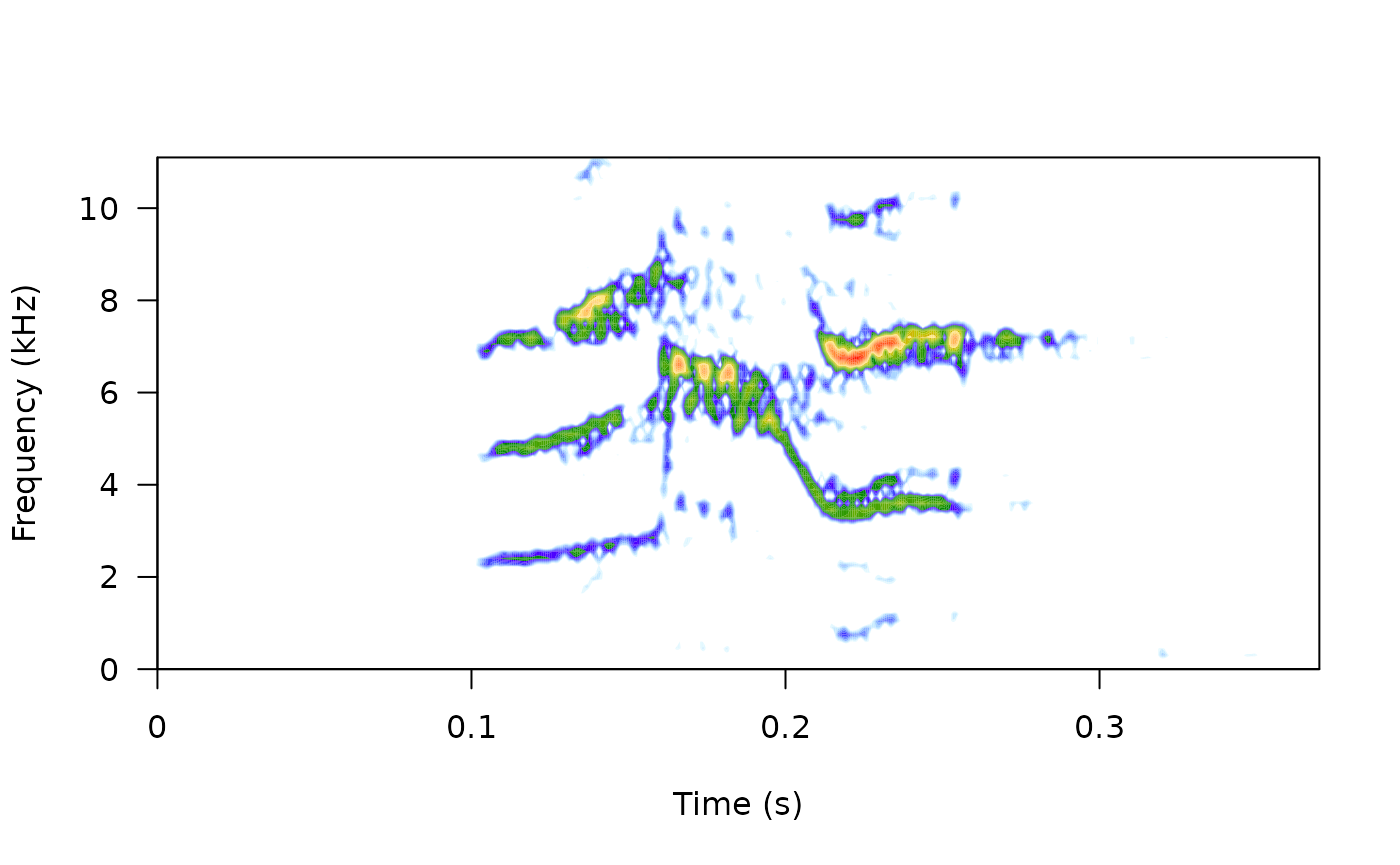
par(mfrow = c(3, 2), mar = rep(0, 4))
for (i in 1:6) {
wv <- read_wave(X = ext_st, index = i, from = 0.05, to = 0.32)
spectro(wv,
wl = 150, grid = FALSE, scale = FALSE, axisX = FALSE,
axisY = FALSE, ovlp = 90
)
}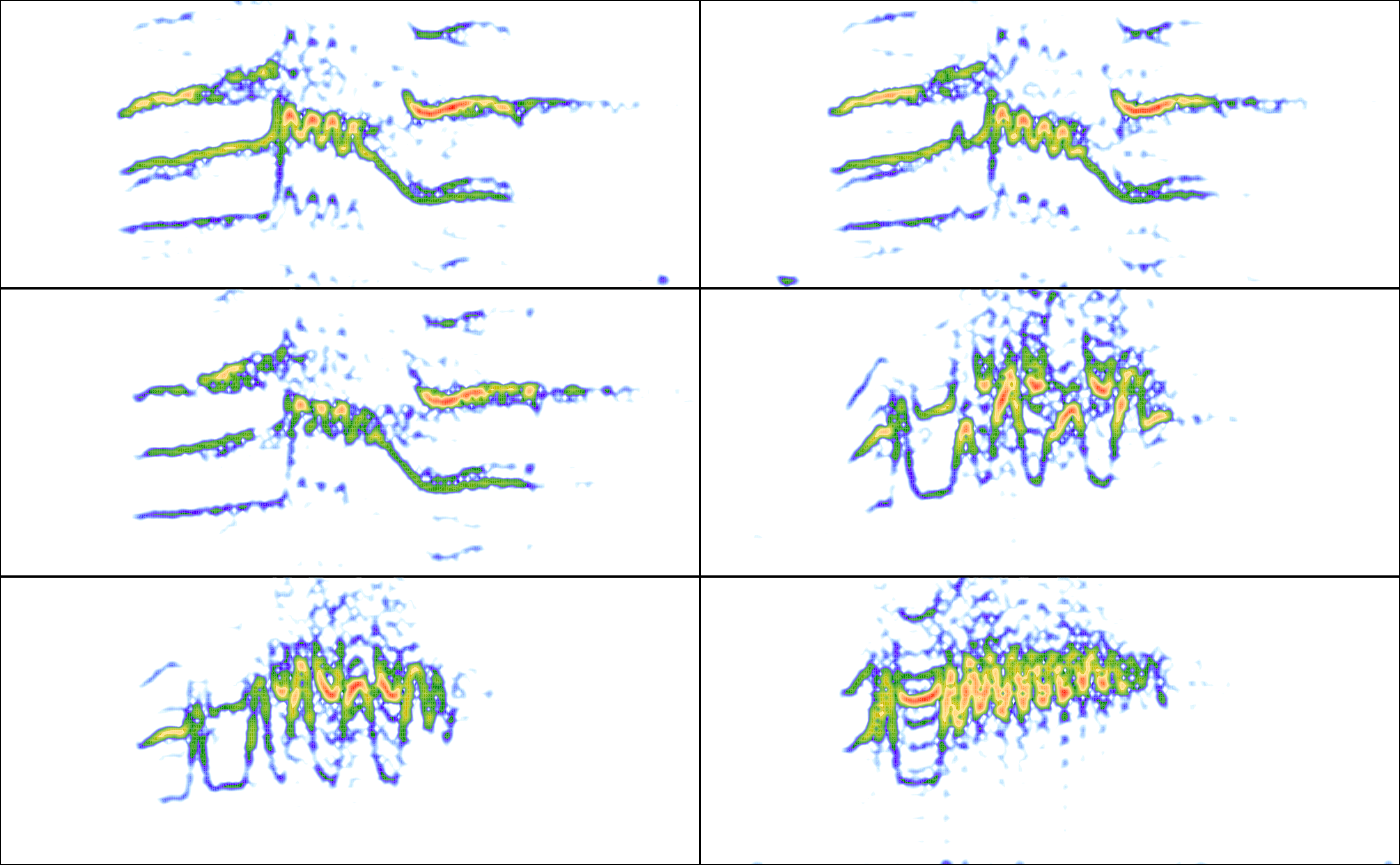
The read_wave() function requires the selection table,
as well as the row index (i.e. the row number) to be able to read the
‘wave’ objects. It can also read a regular ‘wave’ file if the path is
provided.
Note that other functions that modify data frames are likely to delete the attributes in which the ‘wave’ objects and metadata are stored. For example, the merge and the extended selection box will remove its attributes:
# create new data frame
Y <- data.frame(sound.files = ext_st$sound.files, site = "La Selva", lek = c(rep("SUR", 5), rep("CCL", 6)))
# combine
mrg_ext_st <- merge(ext_st, Y, by = "sound.files")
# check class
is_extended_selection_table(mrg_ext_st)[1] FALSE
In this case, we can use the
fix_extended_selection_table() function to transfer the
attributes of the original extended selection table:
# fix est
mrg_ext_st <- fix_extended_selection_table(X = mrg_ext_st, Y = ext_st)
# check class
is_extended_selection_table(mrg_ext_st)[1] TRUE
This works as long as some of the original sound files are retained and no other selections are added.
Analysis using extended selection tables
These objects can be used as input for most warbleR functions. Here are some examples of warbleR functions using extended_selection_table:
Performance
The use of extended_selection_table objects can improve
performance (in our case, measured as time). Here we use
microbenchmark to compare the performance of
sig2noise() and ggplot2 to plot the
results. First, a selection table with 1000 selections is created simply
by repeating the sample data frame several times and then is converted
to an extended selection table:
# create long selection table
lng.selec.table <- do.call(rbind, replicate(10, lbh_selec_table,
simplify = FALSE
))
# relabels selec
lng.selec.table$selec <- 1:nrow(lng.selec.table)
# create extended selection table
lng_ext_st <- selection_table(
X = lng.selec.table,
pb = FALSE,
extended = TRUE
)
# load packages
library(microbenchmark)
library(ggplot2)
# check performance
mbmrk.snr <- microbenchmark(extended = sig2noise(lng_ext_st,
mar = 0.05
), regular = sig2noise(lng.selec.table,
mar = 0.05
), times = 50)
autoplot(mbmrk.snr) + ggtitle("sig2noise")
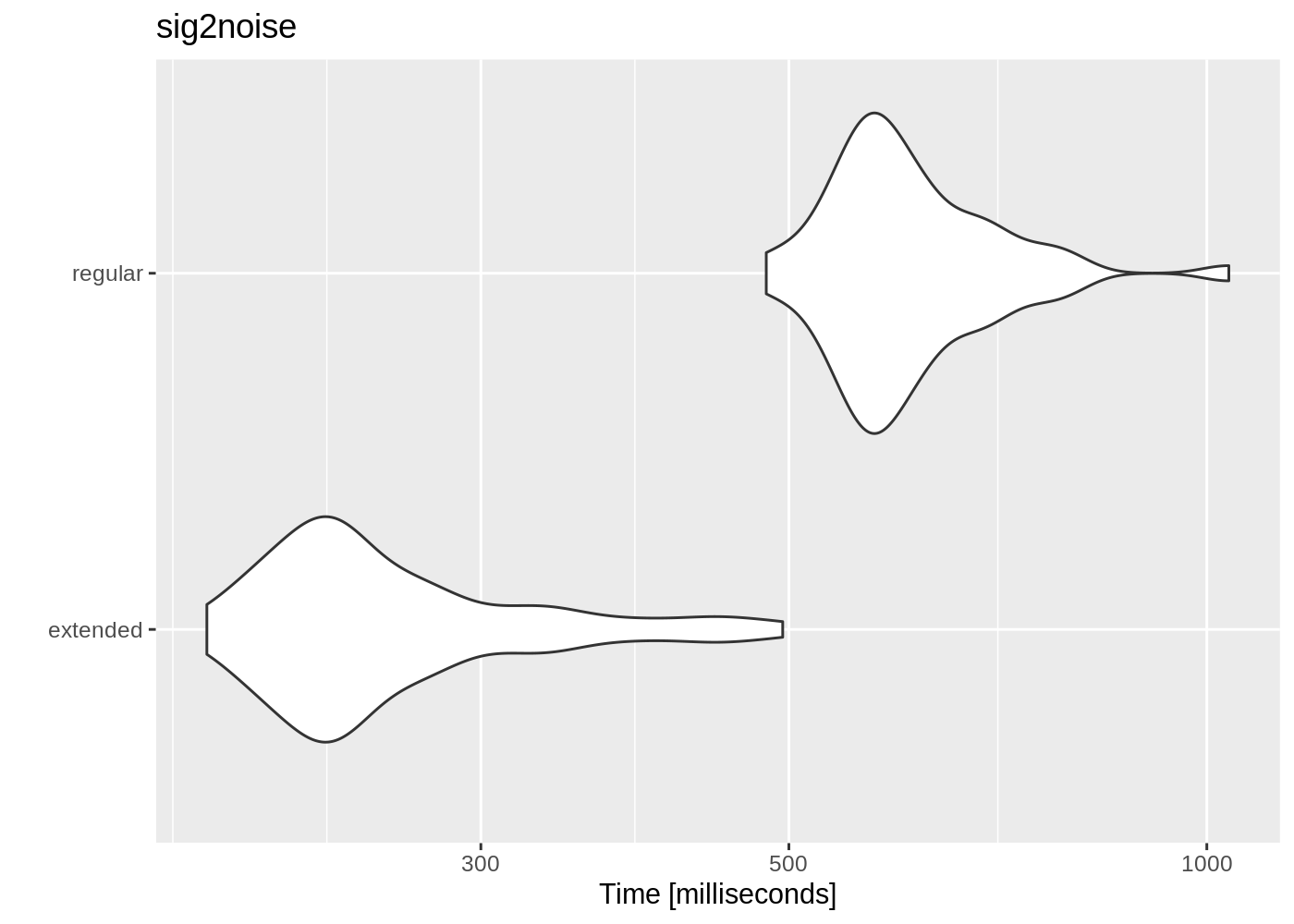
The function runs much faster in the extended selection tables. Performance gain is likely to improve when longer recordings and data sets are used (that is, to compensate for computing overhead).
Sharing acoustic data
This new object class allows to share complete data sets, including acoustic data. For example, the NatureSounds package contains an extended selection table with long-billed hermit hummingbirds vocalizations from 10 different song types:
data("Phae.long.est")
Phae.long.est
[30mObject of class
[1m'extended_selection_table'
[22m
[39m
[90m
[1m
Contains:
[22m
* A selection table data frame with 50 row(s) and 8 columns:
[39m
[90m|sound.files | selec| start| end| bottom.freq| top.freq|
[39m
[90m|:-----------|-----:|-----:|------:|-----------:|--------:|
[39m
[90m|BR2-A1-1 | 1| 0.1| 0.2676| 1.6020| 10.9525|
[39m
[90m|BR2-A1-2 | 1| 0.1| 0.2652| 1.8914| 11.0250|
[39m
[90m|BR2-A1-3 | 1| 0.1| 0.2716| 1.7177| 11.0250|
[39m
[90m|BR2-A1-4 | 1| 0.1| 0.2701| 1.8335| 11.0250|
[39m
[90m|BR2-A1-5 | 1| 0.1| 0.2770| 2.1229| 11.0250|
[39m
[90m|CCE-I3-1 | 1| 0.1| 0.2490| 1.7551| 11.0250|
[39m
[90m... 2 more column(s) (lek, lek.song.type)
[39m
[90m and 44 more row(s)
[39m
[90m
* 50 wave object(s) (as attributes):
[39m
[90mBR2-A1-1, BR2-A1-2, BR2-A1-3, BR2-A1-4, BR2-A1-5, CCE-I3-1
[39m
[90m... and 44 more
[39m
[90m
* A data frame (check.results) with 50 rows generated by check_sels() (as attribute)
[39m
[90m
The selection table was created
[3m
[1m by element
[22m
[23m(see 'class_extended_selection_table')
[39m
[90m* 1 sampling rate(s) (in kHz):
[1m22.05
[22m
[39m
[90m* 1 bit depth(s):
[1m8
[22m
[39m
[90m* Created by warbleR < 1.1.21
[39m
table(Phae.long.est$lek.song.type)
BR2-A1 CCE-I3 LOC-D1 SAT-F1 STR-A2 SUR-E1 SUR-K4 TR1-C2 TR1-C5 TR1-D4
5 5 5 5 5 5 5 5 5 5 The ability to compress large data sets and the ease of performing analyzes that require a single R object can simplify the exchange of data and the reproducibility of bioacoustic analyzes.
warbleR functions and the workflow of analysis in bioacoustics
Bioacoustic analyzes generally follow a specific processing sequence and analysis. This sequence can be represented schematically like this:
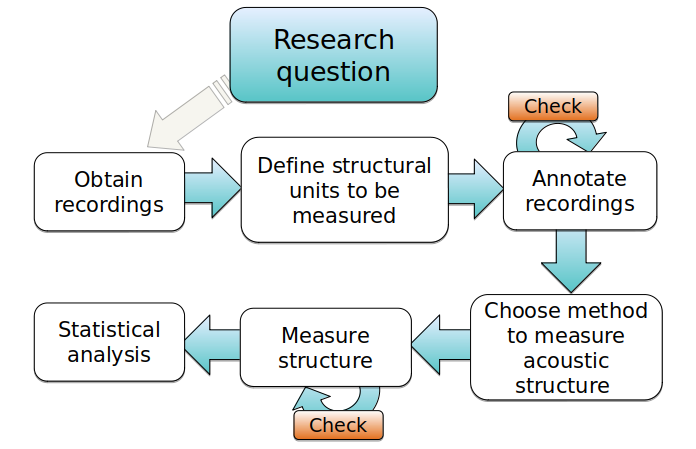
We can group warbleR functions according to the bioacoustic analysis stages.
Get and prepare recordings
The query_xc() function allows you to search and
download sounds from the free access database Xeno-Canto. You can also convert
.mp3 files to .wav, change the sampling rate of the files and correct
corrupt files, among other functions.
| Function | Description | Works on | Output |
|---|---|---|---|
| check_wavs | verify if sound files can be read | multiple wave files | data frame |
| consolidate | consolidate sound files in a single folder | multiple wave files | data frame and wave files |
| fix_wavs | fix waves that cannot be read in R | multiple wave files | wave files |
| mp32wav | convert multiple mp3 files to wav format | multiple mp3 files | wave files |
| query_xc | Search and download mp3 files from Xeno-Canto | Scientific names/data frame | mp3 files |
| resample_est | resample wave objects in ext. selection tables | extended selection tables | extended selection tables |
| remove_channels | remove channels in multiple wave files | multiple wave files | wave files |
| remove_silence | remove silences in multiple wave files | multiple wave files | wave files |
| duration_wavs | measures duration in multiple wave files | multiple wave files | data frame |
| info_wavs | extract recording parameters from multiple wave files | multiple wave files | data frame |
Annotating sound
It is recommended to make annotations in other programs and then import them into R (for example in Raven and import them with the Rraven package). However, warbleR offers some functions to facilitate manual or automatic annotation of sound files, as well as the subsequent manipulation:
| Function | Description | Works on | Output |
|---|---|---|---|
| auto_detec | automatic annotation of wave files | multiple wave files | data frame, images |
| freq_range | detect frequency range in selection tables | multiple wave files | data frame |
| tailor_sels | interactive tailoring of selections | selection tables | selection tables |
Organize annotations
The annotations (or selection tables) can be manipulated and refined with a variety of functions. Selection tables can also be converted into the compact format extended selection tables:
| Function | Description | Works on | Output |
|---|---|---|---|
| tailor_sels | interactive tailoring of selections | selection tables | selection tables |
| sort_colms | order columns in an intuitive way | selection tables | selection tables |
| cut_sels | save selections as individual wave files | selection tables | wave files |
| filter_sels | subset selection tables based on filtered image files | selection tables, ext. selection tables, images | selection tables, ext. selection tables |
| fix_extended_selection_table | add wave objects to extended selection tables | selection tables | extended selection tables |
| selection_table | create selection tables and extended selection tables | selection tables | selection tables, ext. selection tables |
| song_analysis | measures acoustic parameters at higher structural levels of organization | selection tables, ext. selection tables | data frame, selection tables |
Measure acoustic signal structure
Most warbleR functions are dedicated to quantifying the structure of acoustic signals listed in selection tables using batch processing. For this, 4 main measurement methods are offered:
- Spectrographic parameters
- Cross correlation
- Dynamic time warping (DTW)
- Statistical descriptors of cepstral coefficients
Most functions gravitate around these methods, or variations of these methods:
| Function | Description | Works on | Output |
|---|---|---|---|
| freq_range | detect frequency range in selection tables | multiple wave files | data frame |
| song_analysis | measures acoustic parameters at higher structural levels of organization | selection tables, ext. selection tables | data frame, selection tables |
| compare_methods | compare the performance of methods to measure acoustic structure | selection tables, ext. selection tables | images |
| freq_DTW | measures dynamic time warping (DTW) on dominant/fundamental frequency contours | selection tables, ext. selection tables | (di)similarity matrix, images |
| freq_ts | mesaures dominant/fundamental frequency contours | selection tables, ext. selection tables | data frame with frequency contours |
| inflections | measures number of inflections in frequency contours | data frame with frequency contours | data frame |
| mfcc_stats | measures statistical descriptors of Mel cepstral coefficients | selection tables, ext. selection tables | data frame |
| multi_DTW | measures dynamic time warping (DTW) on multiple contours | selection tables, ext. selection tables | (di)similarity matrix |
| sig2noise | measures signal-to-noise ratio | selection tables, ext. selection tables | selection tables, ext. selection tables |
| spectro_analysis | measures spectrographic parameters | selection tables, ext. selection tables | data frame |
| cross_correlation | measurec spectrographic cross-correlation | selection tables, ext. selection tables | (di)similarity matrix |
Verify annotations
Functions are provided to detect inconsistencies in the selection tables or modify selection tables. The package also offers several functions to generate spectrograms showing the annotations, which can be organized by annotation categories. This allows you to verify if the annotations match the previously defined categories, which is particularly useful if the annotations were automatically generated.
| Function | Description | Works on | Output |
|---|---|---|---|
| check_sels | double-check selection tables | selection tables | selection tables |
| overlapping_sels | finds (time) overlapping selections | selection tables, ext. selection tables | selection tables, ext. selection tables |
| catalog | creates spectrogram catalog | selection tables, ext. selection tables | images |
| catalog2pdf | convert catalogs to .pdf | images | images |
| spectrograms | create spectrogram images | selection tables, ext. selection tables | images |
| full_spectrograms | create spectrograms of whole sound files | multiple wave files, selection tables, ext. selection tables | images |
| full_spectrogram2pdf | convert full spectrograms to .pfg | images | images |
Visually inspection of annotations and measurements
| Function | Description | Works on | Output |
|---|---|---|---|
| snr_spectrograms | plots spectrograms highlighting areas where signal-to-noise ratio is measured | selection tables, ext. selection tables | images |
| spectrograms | create spectrogram images | selection tables, ext. selection tables | images |
| track_freq_contour | create spectrogram images including frequency contours | selection tables, ext. selection tables | images |
| plot_coordination | create schematic plots of coordinated signals | data frame | images |
| full_spectrograms | create spectrograms of whole sound files | multiple wave files, selection tables, ext. selection tables | images |
Additional functions
Finally, warbleR offers functions to simplify the use of extended selection tables, organize large numbers of images with spectrograms and generate elaborated signal visualizations:
| Function | Description | Works on | Output |
|---|---|---|---|
| is_extended_selection_table | check if object is extended selection tables | data frame | TRUE/FALSE |
| is_selection_table | check if object is selection tables | data frame | TRUE/FALSE |
| catalog2pdf | convert catalogs to .pdf | images | images |
| move_imgs | moves images among folders | images | images |
| map_xc | created maps from Xeno-Canto recordings | data frame | images |
| test_coordination | test statistical significance of vocal coordination | data frame | data frame |
| full_spectrogram2pdf | convert full spectrograms to .pfg | images | images |
| color_spectro | highlight signals with colors in a spectrogram | wave object | plot in R |
| freq_range_detec | detect frequency range in wave objetcs | wave object | data frame, plot in R |
| open_wd | open working directory | ||
| phylo_spectro | plots phylogenetic trees with spectrograms | selection tables | plot in R |
| read_wave | read wave files and wave objects | selection tables, ext. selection tables | wave object |
| sim_songs | simulate songs | wave object, wave file and selection table | |
| tweak_spectro | creates mosaic plots with spectrograms with different display parameters | selection tables, ext. selection tables | images |
| warbleR_options | define global parameters for warbleR functions |
References
- Araya-Salas M, G Smith-Vidaurre & M Webster. 2017. Assessing the effect of sound file compression and background noise on measures of acoustic signal structure. Bioacoustics 4622, 1-17
- Araya-Salas M, Smith-Vidaurre G (2017) warbleR: An R package to streamline analysis of animal acoustic signals. Methods Ecol Evol 8:184-191.
Session information
R version 4.3.2 (2023-10-31)
Platform: x86_64-pc-linux-gnu (64-bit)
Running under: Ubuntu 22.04.4 LTS
Matrix products: default
BLAS: /usr/lib/x86_64-linux-gnu/openblas-pthread/libblas.so.3
LAPACK: /usr/lib/x86_64-linux-gnu/openblas-pthread/libopenblasp-r0.3.20.so; LAPACK version 3.10.0
locale:
[1] LC_CTYPE=C.UTF-8 LC_NUMERIC=C LC_TIME=C.UTF-8 LC_COLLATE=C.UTF-8
[5] LC_MONETARY=C.UTF-8 LC_MESSAGES=C.UTF-8 LC_PAPER=C.UTF-8 LC_NAME=C
[9] LC_ADDRESS=C LC_TELEPHONE=C LC_MEASUREMENT=C.UTF-8 LC_IDENTIFICATION=C
time zone: UTC
tzcode source: system (glibc)
attached base packages:
[1] stats graphics grDevices utils datasets methods base
other attached packages:
[1] kableExtra_1.4.0 warbleR_1.1.30 NatureSounds_1.0.4 knitr_1.45 seewave_2.2.3
[6] tuneR_1.4.6
loaded via a namespace (and not attached):
[1] sass_0.4.8 xml2_1.3.6 bitops_1.0-7 stringi_1.8.3 digest_0.6.34
[6] magrittr_2.0.3 evaluate_0.23 fastmap_1.1.1 jsonlite_1.8.8 brio_1.1.4
[11] purrr_1.0.2 viridisLite_0.4.2 scales_1.3.0 pbapply_1.7-2 textshaping_0.3.7
[16] jquerylib_0.1.4 cli_3.6.2 rlang_1.1.3 fftw_1.0-8 munsell_0.5.0
[21] cachem_1.0.8 yaml_2.3.8 tools_4.3.2 parallel_4.3.2 memoise_2.0.1
[26] colorspace_2.1-0 vctrs_0.6.5 R6_2.5.1 proxy_0.4-27 lifecycle_1.0.4
[31] dtw_1.23-1 stringr_1.5.1 fs_1.6.3 MASS_7.3-60 ragg_1.2.7
[36] desc_1.4.3 pkgdown_2.0.7 bslib_0.6.1 glue_1.7.0 Rcpp_1.0.12
[41] systemfonts_1.0.5 highr_0.10 xfun_0.42 rstudioapi_0.15.0 rjson_0.2.21
[46] htmltools_0.5.7 rmarkdown_2.25 svglite_2.1.3 testthat_3.2.1 signal_1.8-0
[51] compiler_4.3.2 RCurl_1.98-1.14